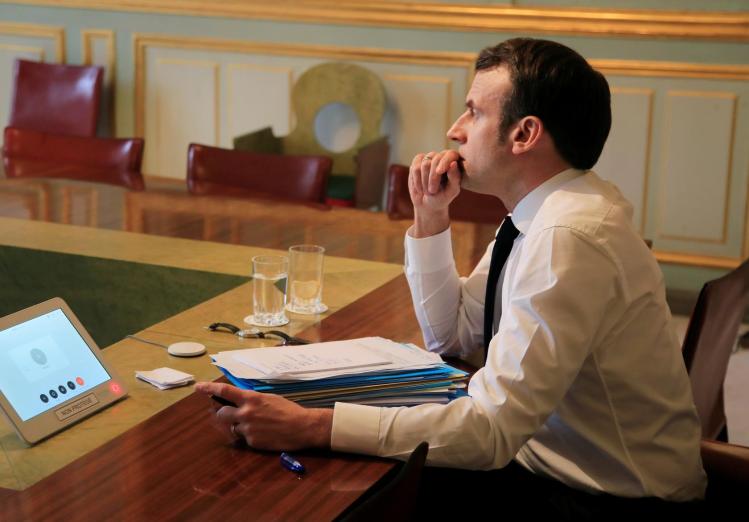Following a decision to close schools next Monday to stem the spread of COVID-19, France will embark on a massive experiment in distance learning.
French President Emmanuel Macron announced the school closure in a national address on Thursday night, when he called for unity and shared sacrifice.
“You have been able to not give in to fear or panic,” Macron said. “You have been able to place the greater good of all above [your] own personal interests, and that is because we share values of solidarity and brotherhood.”
The adoption of distance learning comes as organizers and associations around the world adapt to rules prohibiting large gatherings. Across the board, the cancellation of sporting events, conferences, and concerts has sent organizers scrambling to replace them with virtual equivalents.
June 5th: The AI Audit in NYC
Join us next week in NYC to engage with top executive leaders, delving into strategies for auditing AI models to ensure fairness, optimal performance, and ethical compliance across diverse organizations. Secure your attendance for this exclusive invite-only event.
The decision to close schools came after days of speculation and the French Education Minister’s insistence that it was unlikely to happen. Now it’s up to that same minister, Jean-Michel Blanquer, to coordinate the online learning system.
In a tweet, and in numerous media appearances, Blanquer insisted the country is prepared for such a dramatic pivot. Today, students throughout the country are attending what will be their final day of on-site schooling for at least several weeks and receiving instructions for using the distance learning platform.
“In this new step in the fight against the coronavirus, we will close the elementary, middle, and high schools,” Blanquer tweeted. “Each academy is prepared with a plan that is practical and appropriate for each level of education. The deployment of our distance learning system will take place throughout the whole country.”
Dans cette nouvelle étape de la lutte contre le #coronavirus nous fermons les écoles les collèges et les lycées.
Chaque académie y est préparée sur le plan pratique et pédagogique.
Le déploiement de notre système d’enseignement à distance va s’enclencher pour toute la France. https://t.co/h3gGSGb48k— Jean-Michel Blanquer (@jmblanquer) March 12, 2020
The Education Ministry’s National Center for Distance Education (CNED) had already developed an e-learning platform that as of 2017 was being used by 237,000 students around the world. Blanquer said the platform has a 15 million-student capacity and that France has around 13 million students from kindergarten through high school.
Of course, a shift from physical to virtual classrooms presents not just technical challenges, but social ones as well. It’s not clear what France will do for students who don’t have internet access or computers or how well the system will work in households that lack broadband.
The leader of France’s main teachers’ union, Francette Popineau, told The Local that while she supports the decision, she’s not sure the country is really prepared for the challenge ahead.
“Organizing virtual classrooms would require all parents having access to a computer and a webcam. It’s a very complicated process. We don’t have the tools necessary, and teachers haven’t been trained to do it,” Popineau said in the interview. “It’s important that these tasks are tailored so that the children are able to do them autonomously, without depending on their parents.”
Still, parents will likely need to be involved in some form, which presents another challenge. Macron has urged as many people as possible to work from home in a parallel attempt to slow the spread of COVID-19. But in cases where that’s not possible, parents may need to stay home and take sick leave. France’s Labor Minister has confirmed that any parent who must stay home with a child 16 years old or younger will have the right to sick pay.
These kinds of social protections make it easier for France to tackle distance learning than it would be for countries like the U.S.
And although details weren’t immediately clear, Macron said the government was looking at alternative forms of childcare during this period. France offers national childcare and preschool, though those centers are also closing to protect public health.
Making the situation even more complex, some schools will offer alternate distance learning options. Our son, for instance, attends a French high school that also has a British education section. Those English language classes will use Google Classroom, we were informed in an email.
And U.K.-based Twinkl has offered parents of students in the British section of the school a one-month free trial of its e-learning platform to augment other studies.
The hope, of course, is that this is all temporary. French students have a two-week vacation period in April (the weeks vary from region to region). Though the government did not set a time line, many hope courses will resume after that break.
Still, France’s dramatic shift to a distance learning system may provide lessons for other countries as school systems around the world begin to close.
If the system functions well, it could accelerate adoption of the digital tools being trialed. But if it stumbles, or if social barriers render the benefits unequal, people will be seriously rethinking the effectiveness of such systems in the near future.

